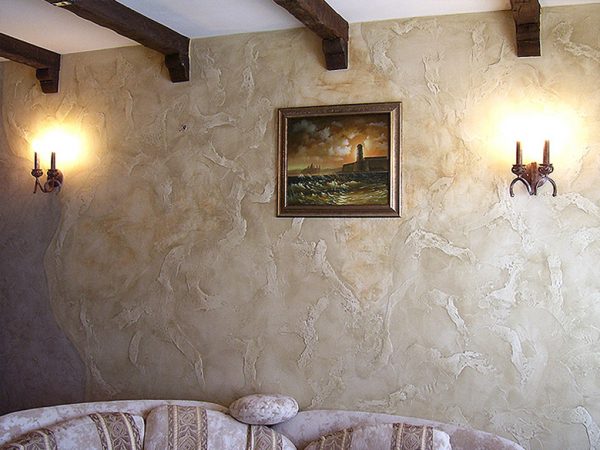The choice of material for interior decoration is not an easy task. Everyone wants him to look harmoniously in the interior, be beautiful, durable and practical.
- Description and history of the appearance of plaster
- Types of material
- Colors and Design
- Application area
- Advantages and disadvantages
- Application technology
- Necessary tools
- Preparatory work
- Mixing and tinting
- Layering Rules
- Base layer
- Second and subsequent layers
- Finish layer
- Ironing
- Waxing
- Methods and Technologies
- Carrara
- Craquelure
- Marseille wax
- Veins
- Marble imitation
- Stucco update
- Repainting the material in a different color
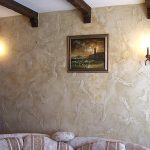
Venetian stucco is an interesting option for home and apartment. It looks luxurious, resembles a natural stone, is applied to any surface and, with proper care, lasts for many years.
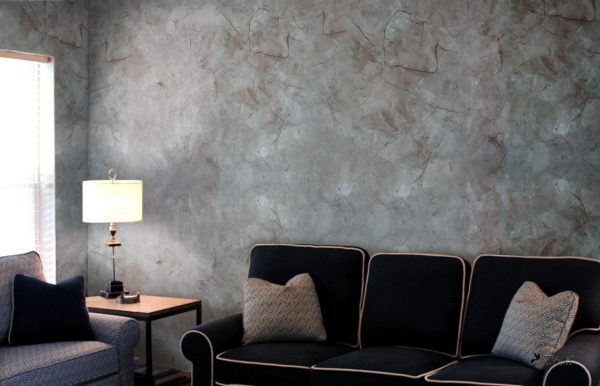
Description and history of the appearance of plaster
Under the Venetian plaster understand a kind of decorative finishing material, which after drying gives a beautiful seamless marble coating. The plaster contains fillers with a fraction of different sizes, can be applied in thin or thick layers, hiding the defects of the base.
Venetian stucco, or liquid marble, was invented in ancient Rome. Masters noticed: if you mix marble dust and lime, and then dilute the mass, when applied to the walls, it will flicker nicely and look like an expensive stone. In the course of experiments, dyes, clay began to be introduced into the composition of the plaster, as a result, the coating changed color and acquired original stains. The walls were covered with material, murals and drawings were made.
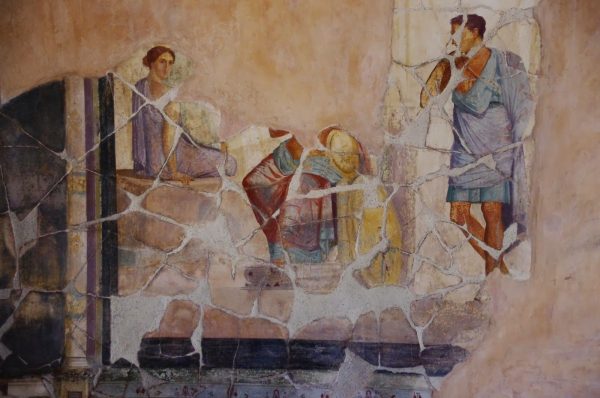
Even more popular decorative plaster received in the Renaissance. In Venice, it was used instead of stone slabs, decorating churches, palaces, houses of wealthy people. Even masters like Raphael and Michelangelo used the material in their work. The finish was almost not afraid of moisture, did not respond to temperature changes, and was also incredibly attractive.
to contents ↑Plaster is widely used and now, however, natural marble in it is often replaced by granite, other types of stone, and modern dyes and harmless polymers are introduced into the composition.
Types of material
By features and texture, all existing varieties of plaster are divided into the following types:
- Smooth. Due to the introduction of a large amount of lime, the surface is light and quite smooth. Applying material requires professional skills.
- Embossed. Due to the presence of medium and large particles of stone, the coating acquires pits, grooves that form a relief.
- Artistic. It is used for painting on walls, it allows you to create real masterpieces of art.
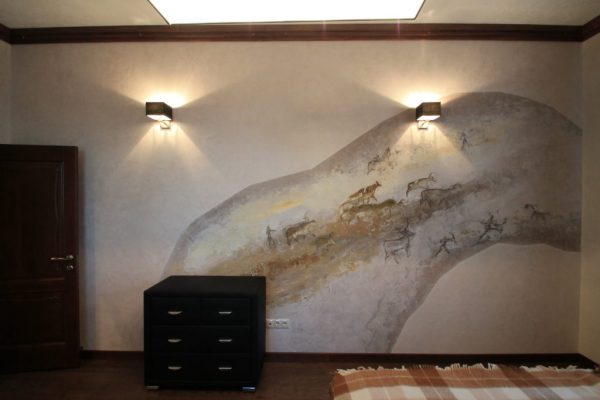
Depending on the composition, you can classify Venetian plaster in this way:
- Classical It consists of fine marble chips, acrylic or other astringent component, lime, hardening agents.It is applied in several layers in the traditional way.
- Marble. The composition is similar to the previous one, but the stone crumb has a slightly larger size and concentration, because of which the finished coating will resemble stone.
- Textured. Such plaster is used in combination with special blending techniques, which make it possible to obtain a “fabric”, “suede”, “leather”, and “wood” surface.
- Mother of pearl. This material contains special reflective particles, so after drying it provides unique optical effects.
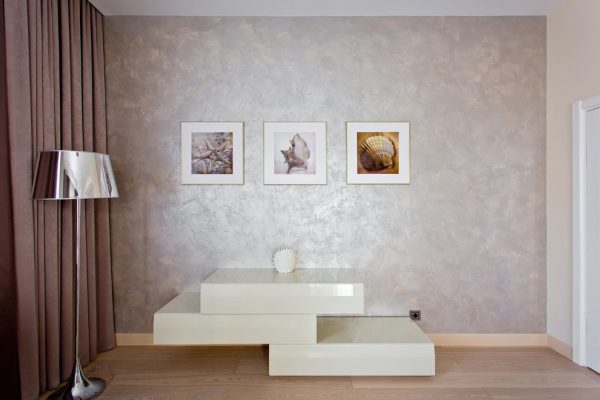
Another classification of Venetian plaster implies a division into two groups:
- Polymer. Most often contains acrylic resins, which give it strength, improve adhesion to the base, increase resistance to temperature extremes. This type of plaster is ideally suited for work on metal, MDF, concrete, drywall. Instead of acrylic, silicone can be introduced into the composition of the Venetian plaster, and then it will have increased moisture resistance and elasticity.
- Mineral Includes cement, lime, silica chips. It has an excellent vapor permeability indicator, is not affected by mold, fungus, suitable for outdoor use, as it is not afraid of frost. It is not covered by cracks, repels pollution.
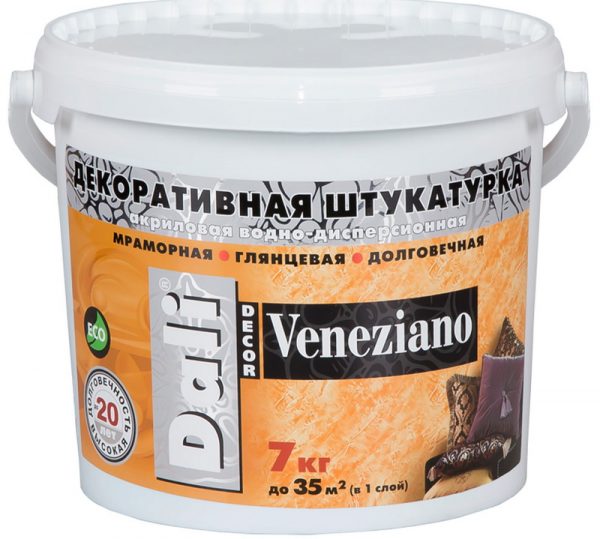
Colors and Design
Professional finishers know different techniques for applying Venetian plaster, thanks to which you can get many different textures. Classical (smooth) texture is less popular than embossed. Design of walls with decorative plaster can be as follows:
- Carrara It includes up to 12 different plaster layers, each of which differs by a half tone from the previous one. Can play in the sun in many shades.
- Craquelure. It creates the effect of antiquity, as the surface is covered with a network of cracks.
- Veneto. It imitates marble, while it may have a smooth or moderately embossed texture.
- Marbello After drying, the coating becomes dull, velvety with small glossy veins. Stucco changes hue and depth depending on the lighting.
- Travertino. It is applied to the surface in 10-12 layers using a special technique to create the effect of natural rock travertine. Ideal for baroque, vintage styles.
- Encausto. The finished surface will be matte, resembling granite. Enhances a similar effect by applying special wax on top of the plaster.
- Wet silk. Gives the walls a resemblance to an expensive, sophisticated fabric. Compositions containing large silk fibers look most beautiful.
- Imperial A golden pigment is introduced into such a plaster, which is poured by contact with sunlight. The material blends well with vintage and art deco styles.
- Palmier. The stone surface is obtained as if permeated by a network of luminous veins. Most often, the material includes crumbs of malachite, onyx, marble.
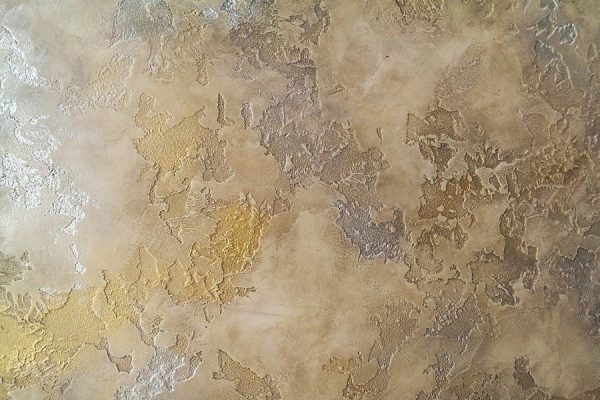
to contents ↑Venetian plaster is sold in different shades. You can find white, beige, blue and greenish, blue and brown tones. To create bright accents, use bright green, black, purple and other colors of plaster.
Application area
Without special protective coating, it is possible to apply Venetian plaster only inside buildings and outside places with high humidity. If you cover the material with a special composition, it is perfect for the kitchen and even for the bathroom. In large rooms it is better to use relief, textured types of plaster, and in small rooms give preference to smooth options. Too bright shades look bad in small rooms - pastel, light tones are more appropriate here.
Venetian plaster is suitable not only for residential premises, but also for offices, shopping centers, concert halls. It can cover walls, ceilings, separate areas, niches, columns and other interior elements.The material goes well with brickwork, stone, wood, dense wallpaper.
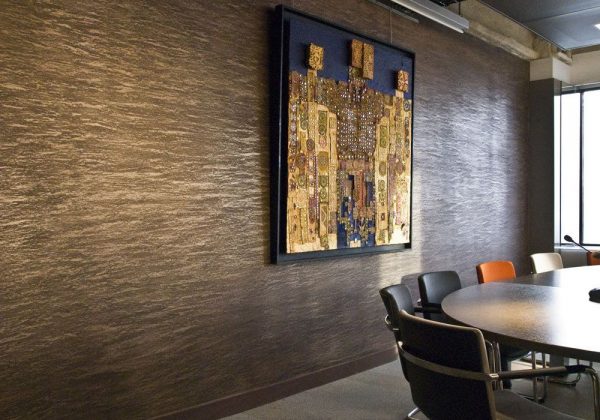
Advantages and disadvantages
Stucco has a huge number of positive qualities. The main ones are:
- Unique look. The texture that imitates stone will always look stylish and luxurious, while the surface is seamless. If you finish with wax, the material will glow at all, shine in the sun. Venetian plaster is realized in rich colors, which allows it to be used in different interior styles, to make drawings and interesting compositions.
- Resistance to adverse factors. Plaster serves for 25 years or more, and all because it is not afraid of moisture, temperature changes (from –25 to +50 degrees), mechanical loads. It does not scratch, does not crack, withstands contact with chemicals.
- Environmental friendliness. The plaster does not contain harmful components, does not have a smell, does not emit toxins even when heated. It is absolutely safe for humans. The material does not violate the microclimate in the house, since it is vapor-permeable. Mold and fungus on the walls also will not start due to the biological inertness of the coating.
- Easy to care. If plaster is applied to the walls, it will be easy to maintain cleanliness in the house. The coating can be washed with water and mild detergents. It will not be spoiled by friction of moderate strength.
Some types of Venetian plaster are suitable for use in baths, saunas: they have increased resistance to heat and contact with water. The color of the material is preserved for many years, it is quite resistant to ultraviolet radiation.
Cons of Venetian plaster are also available. If you apply it with your own hands, without proper experience, you can be disappointed in the effect. To get a coating with a unique texture, you need to know the techniques of its creation. The price of this material is also not happy, and a full finish of the room can cost a decent amount. Nevertheless, the beauty and durability of the plaster make it in demand in the repair.
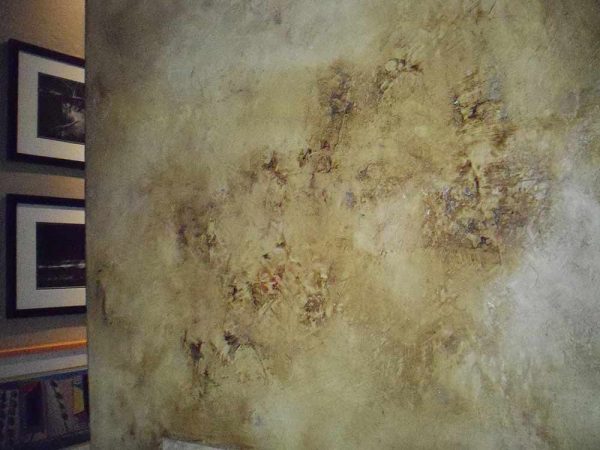
Application technology
There are many ways to apply the material. The result completely depends on the direction, number of strokes: surface type, texture. Only a professional can predict the final effect when working with Venetian plaster, so it is advisable for a beginner to experiment. In order not to waste money in vain, it is better to do test strokes on a small piece of putty and primed plywood. After perfecting the technique, you can proceed to the main stage of work.
to contents ↑Necessary tools
To apply the material you need a special trowel. It differs from the trowel in the trapezoidal shape of the work surface and rounded corners that do not make stripes when smearing the plaster. You also need to prepare the following tools and consumables:
- masking tape;
- a bath;
- steel spatulas (15 cm and 30 cm);
- roller;
- construction mixer or drill with mixer nozzle;
- a machine with a polishing nozzle;
- pigments (if necessary);
- primer, wax and putty (cement plaster);
- venetian plaster.
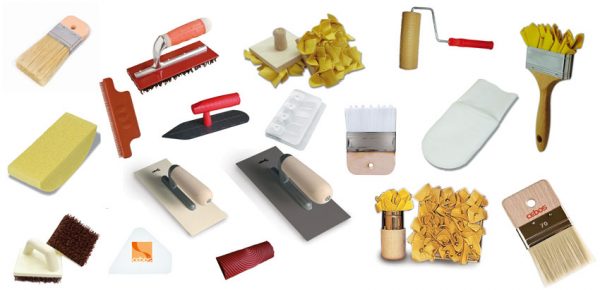
Preparatory work
The base on which the material will be applied should be carefully prepared. The smoother it becomes, the more attractive the coating. All falling off pieces are removed, removed a layer of wallpaper, old paint. Fill with cement mixes and finish with latex putty. Venetian plaster can also smooth out irregularities, but this will seriously increase the cost of decoration. Smooth walls are covered with deep penetration soil 2 times to enhance adhesion and remove dust from the putty.
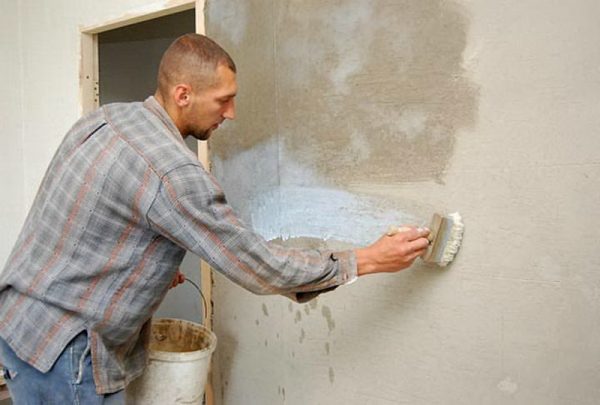
Mixing and tinting
The material is sold in diluted form, in plastic containers of 5-20 kg.If the Venetian plaster is white, it is subject to tinting. In any means, the introduction of nacre, sparkles and other similar additives is permissible. It is best to make a tint in the store, but if you have a construction mixer, you can color the mass at home. If the plaster is covered with a layer of water on top, it must be drained: liquid is added to prevent drying out of the composition. In any case, before application, the material is well kneaded until smooth.
If tinting is carried out independently, you need to remember that at the walls of the container, the plaster is often poorly stained. After beating the mass with a mixer, you should take a clean, thin bar, hold it several times at the walls to mix the material. Then you need to use the construction mixer again. Some manufacturers of plaster indicate that after tinting it is better to leave it for 12 hours and only then apply it for work.
After drying, a number of compounds change color, so for a start you should apply a couple of strokes and wait. You may need to add dye to the plaster or dilute it with a portion of the white mass. With independent tinting, it is not possible to exactly repeat the result in different batches, and with large dimensions of the room it is better to entrust the work to specialists.
to contents ↑Layering Rules
The number of layers can be different, from 2-3 to 12 or more. Their exact number depends on the effect that you want to get. It is important to grind each layer to evenness, smoothness, then let it dry completely.
Base layer
The base is applied evenly, about the same as regular plaster. The mixture for the base layer can not even be tinted, since its task is the final leveling of the base. If there will be no more than three layers, tinting is performed, otherwise the white layer will shine through ugly.
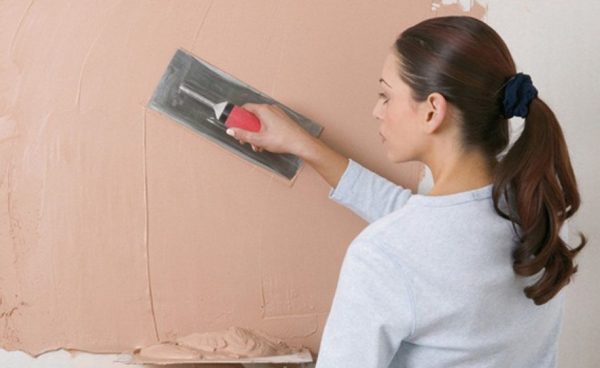
Second and subsequent layers
All other layers are applied with random strokes using trowels and trowels. Usually the composition is spread on the tool from the edges, then transferred to the wall, rubbed in different directions. Try to ensure that the trace from the previous touch of the tool was not noticeable on the surface. To do this, close it with a subsequent smear. It is not necessary to strive for uniformity: the meaning of applying plaster in the randomness of forms, lines, as in natural stone.
After each layer is completed, they wait a few hours (as recommended by the manufacturer), usually no more than ten. As they dry, they overwrite the base with a trowel, smooth out all the differences. The next layer is applied to the cleaned wall, and so on until the desired result is obtained.
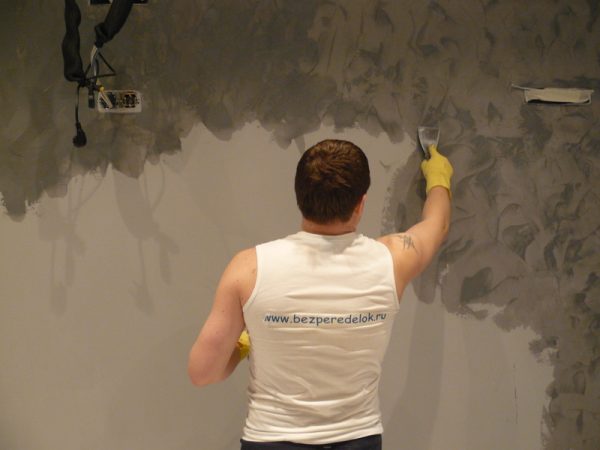
Finish layer
The last layer is performed with a metal spatula, and make it almost transparent. To do this, a little composition is put on a spatula, the blade is pressed tightly against the wall, held, and then, as it were, the mass is collected back. As a result, the coating will remain the thinnest layer of plaster, which will hide the smallest defects.
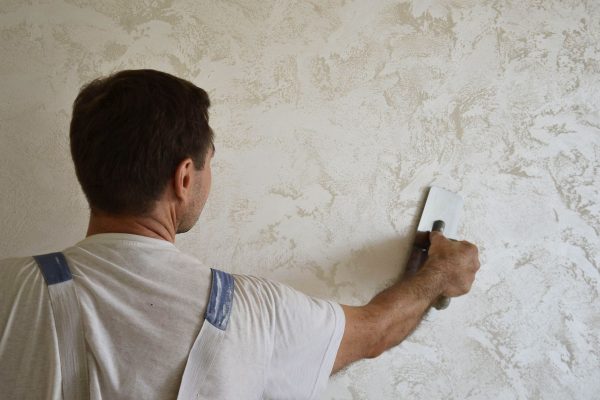
Ironing
The finish layer is not completely dried. After 20-30 minutes after its implementation, ironing is started, and this is done in small areas. Ironing involves grouting with a metal trowel in a circular motion. In the process of such work, shine, pattern, desired texture, layering are manifested.
It is important that the trowel does not have grains of sand, grains, any defects, otherwise it will scratch the wall and ruin the whole picture. After ironing, the coating can be considered finished if it is located in the bedroom, living room. After mashing in the kitchen, bathroom, hall, it is necessary to treat the walls with a special protective compound.
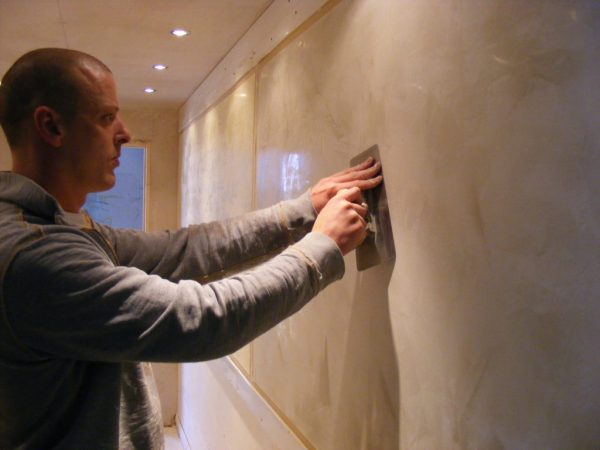
Waxing
For waxing, use natural (bee) or synthetic wax. In the first case, the surface will be glossy, in the second - matte.To process the bathroom, it is better to use synthetic waxes, which have a higher moisture resistance than natural ones.
After ironing, the wax is applied with a wide spatula in one thin layer. After 30 minutes, proceed to polishing. For this purpose, it is most convenient to use a grinder with a special polishing nozzle made of soft pile, which does not crumble. The speed should be set to less than 3000 rpm / min, otherwise the wax will be washed and not polished. Full drying of the wax lasts up to 14 days, and only then can the wall be washed and wiped.
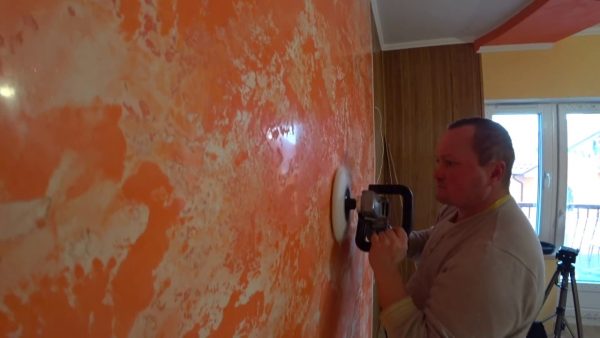
Methods and Technologies
The most popular plastering methods used by professionals are described below.
Carrara
For the production of such Venetian plaster, a special Carrara marble is taken, and the mixture is very expensive. However, now on sale you can find plaster with colored fillers under the marble, which seriously reduces the price. The number of layers should be at least 12, only then the coating will play in the sun with a variety of shades. The strokes of each layer are applied in a different order. Also, the layers differ from each other in shade, which ultimately creates the appearance of multi-colored spots and highlights.
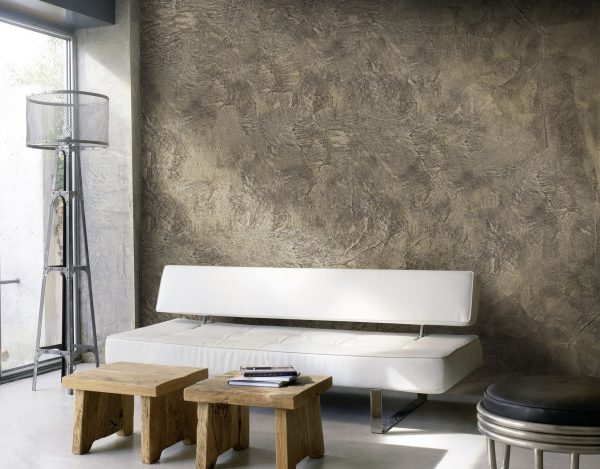
Craquelure
Artificial aging of the surface is achieved through a network of cracks that are obtained after applying craquelure varnish. Gradually hardening, the varnish attracts the upper layer of plaster and tears it apart. The resulting cracks are surface and do not reduce the performance of the coating.
Since craquelure varnish is expensive, a way has been devised to reduce the cost of implementing the technology. After applying the top layer of Venetian plaster, it is forcibly dried using an infrared emitter, as a result, cracks also form on the surface. Then, darker plaster is rubbed into the base, and on top cover it with a colorless protective composition.
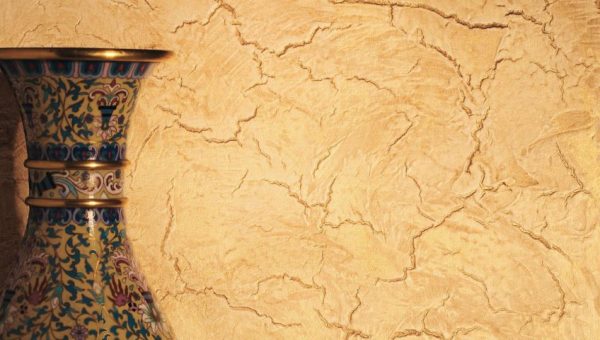
Marseille wax
Such wax is actually a kind of decorative plaster, which provides deep relief to the surface and imitates the texture of stone and wood. The effect is achieved by introducing into the composition of ground and boiled cellulose fibers. After drying, the plaster is coated with special wax-based azure, and the finish layer is unevenly distributed on the surface so that its color is more saturated in the recesses.
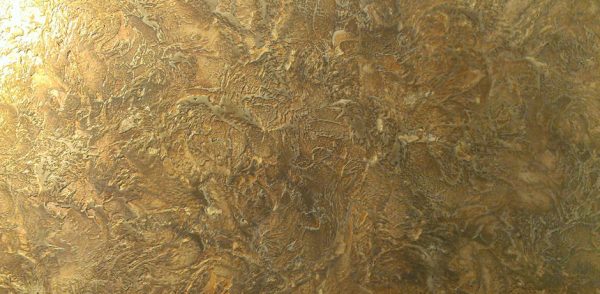
Veins
To obtain interesting veins on the surface of the wall, you need to purchase Venetian plaster with the addition of soot and bituminous marble chips. Smears are performed with the thinnest putty knife, rub well. Each subsequent layer is applied more evenly than the previous one.
Marble imitation
To create an imitation of natural stone on the wall is not an easy task. This finish requires skill and experience. Prepare the base color plaster, as well as a black and white mixture to create streaks. The first layer is made of the main plaster, laying it diagonally from right to left.
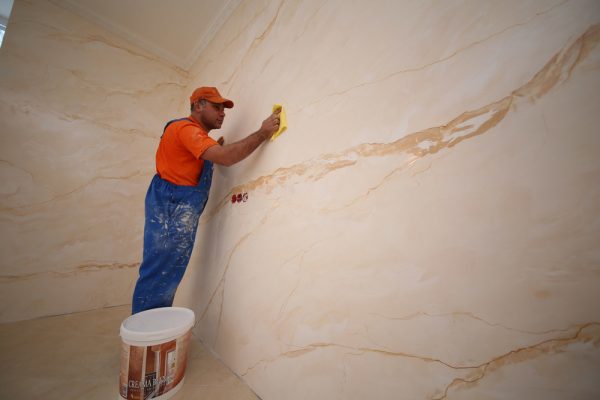
to contents ↑After the base has dried, put on the spatula the material of the main color and a little white and black plaster, mix the compositions lightly with your hand. The mass is applied in a second layer diagonally again from right to left, drawing streaks of veins. When this layer also dries, it is treated with sandpaper with the smallest grain. The last layer is applied wax to give shine to the plaster and in order to protect it.
Stucco update
It happens that during improper use, chips and cracks appear on the coating. To restore the damaged area you need to do this:
- Take a plastic brush, clean the chips from pieces, dust.
- Apply primer to the cleaned place.
- Coat the defect with plaster.
- Allow the composition to dry, wipe it until smooth.
- Apply protective wax, glaze varnish, polish with a cloth.
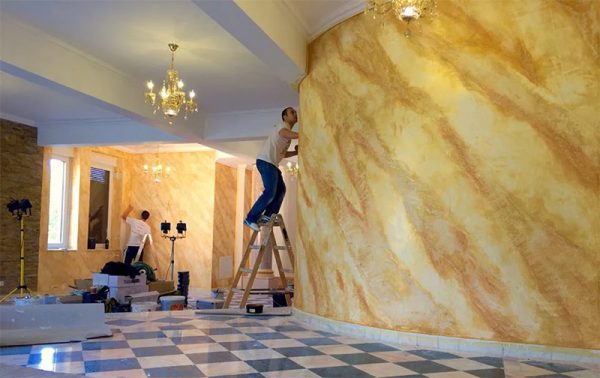
Repainting the material in a different color
Many brands of Venetian plaster are sold in white and are tinted with special concentrated pigments. So you can color the material in any shade. If you want to repaint the already applied coating, this may be prevented by a layer of wax on which the paint does not lie. You will have to remove the wax with careful grinding, and then apply the paint. It must be remembered that the material after such manipulations will no longer resemble so much natural stone, although it will retain an interesting relief.
With the help of Venetian plaster, you can make the apartment truly luxurious. The material gives any room a royal look, moreover, it is durable and wear-resistant, so its popularity does not decrease over time.



